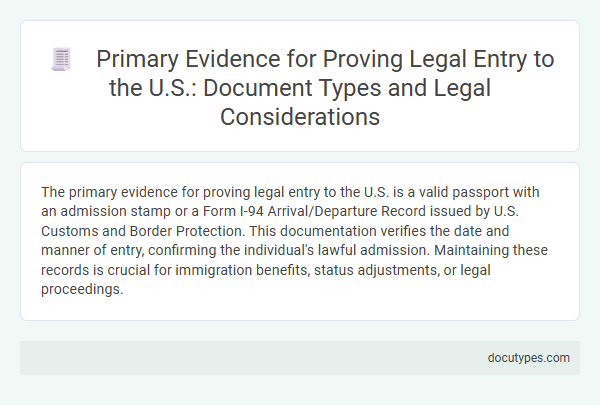The primary evidence for proving legal entry to the U.S. is a valid passport with an admission stamp or a Form I-94 Arrival/Departure Record issued by U.S. Customs and Border Protection. This documentation verifies the date and manner of entry, confirming the individual's lawful admission. Maintaining these records is crucial for immigration benefits, status adjustments, or legal proceedings.
Introduction to Legal Entry Requirements in the U.S.
Legal entry to the U.S. requires specific documentation to prove authorized admission. Primary evidence includes visas, I-94 arrival/departure records, and passports endorsed by a U.S. immigration officer. Understanding these requirements ensures your lawful presence is properly verified upon entry.
Understanding Primary Evidence for U.S. Entry
Understanding the primary evidence for proving legal entry to the U.S. is essential for immigration processes. This evidence confirms lawful admission and helps establish eligibility for various benefits and status adjustments.
- Form I-94 Arrival/Departure Record - This document serves as the official record of your entry to and exit from the United States.
- Passport with U.S. Admission Stamp - A valid passport bearing the U.S. Customs and Border Protection stamp verifies your lawful entry date and port of entry.
- Form I-797 Notice of Action - In some cases, this form confirms approval of your visa or status, indirectly supporting your legal entry proof.
You must provide one of these primary documents to demonstrate lawful presence in the country effectively.
Valid Passports and Visa Stamps as Proof of Admission
Valid passports and visa stamps serve as the primary evidence for proving legal entry to the United States. These documents verify identity and the authorization granted by U.S. immigration authorities upon arrival.
Your passport must contain a valid visa stamp or entry endorsement from Customs and Border Protection (CBP) to confirm lawful admission. Immigration officers use these stamps to record the date and status of entry into the country.
Form I-94: Arrival/Departure Records Explained
| Primary Evidence for Proving Legal Entry to the U.S. | |
|---|---|
| Key Document | Form I-94: Arrival/Departure Record |
| Purpose | Form I-94 serves as the official record issued by U.S. Customs and Border Protection (CBP) upon your arrival to the United States, confirming your legal entry. |
| Information Included |
|
| Format | Electronic record accessible online, with a printed copy available upon request at ports of entry or CBP websites. |
| Importance | Form I-94 is the primary evidence for proof of a lawful entry, used in immigration processes including visa extensions, adjustment of status, and naturalization applications. |
| How to Access | You can retrieve your I-94 record on the U.S. Customs and Border Protection website by entering your personal travel information. |
Border Crossing Cards: Eligibility and Use
Border Crossing Cards (BCC) serve as primary evidence for proving legal entry to the U.S. for residents of Mexico living near the border. These cards allow for multiple short-term entries primarily for tourism, business, or medical visits.
To be eligible for a BCC, applicants must reside in the Mexican border region and pass a background check ensuring no immigration violations. Your BCC must be presented alongside a valid passport when crossing the U.S. border for inspection by Customs and Border Protection officers.
Admission Stamps and Their Legal Significance
Admission stamps serve as primary evidence for proving legal entry to the United States and are critical in immigration cases. These stamps, placed by Customs and Border Protection officers, indicate the date, port of entry, and visa status of the traveler.
The legal significance of admission stamps lies in their role in verifying lawful presence and authorized duration of stay. Immigration authorities rely on these stamps to determine compliance with visa terms and eligibility for benefits. Absence or alteration of admission stamps can complicate or jeopardize immigration processes.
Electronic Travel Authorization Documentation
Electronic Travel Authorization (ETA) documentation serves as primary evidence for proving legal entry to the U.S. This digital approval is issued by the Department of Homeland Security and confirms that You have been authorized to travel to the United States under specific visa waiver programs. Presenting your ETA status during immigration checks verifies lawful entry and facilitates access to U.S. borders without traditional visas.
Legal Entry for Asylees and Refugees: Required Documents
What is the primary evidence required to prove legal entry to the U.S. for asylees and refugees?
Asylees and refugees must present specific government-issued documents that confirm their legal entry status. Key documents include Form I-94 Arrival/Departure Record and the refugee travel document issued by the U.S. Citizenship and Immigration Services (USCIS) or Department of State.
Common Issues and Discrepancies with Entry Records
The primary evidence for proving legal entry to the U.S. is an I-94 Arrival/Departure Record, which serves as official documentation of your entry and lawful status. Discrepancies or missing information in entry records often create challenges during immigration processes.
- Incomplete or Missing I-94 Records - Errors or absence of the I-94 can delay or complicate immigration benefits and status verification.
- Mismatched Personal Information - Differences in name spelling, dates, or passport numbers between documents and entry records raise red flags for immigration authorities.
- Incorrect Entry Dates - Disputed entry dates in official records may affect eligibility for benefits tied to lawful presence duration.
What Is the Primary Evidence for Proving Legal Entry to the U.S.? Infographic

